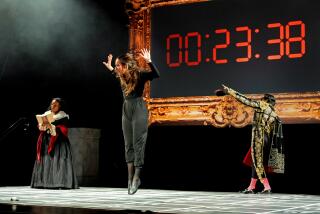For John Cage, Life’s Still a Trip on a River of Sound
- Share via
To illustrate the difference between music and mere sound, many musicologists resort to hair-splitting definitions. For composer John Cage, all sound is music.
“I like ambient sound. I don’t object to burglar alarms or hums from refrigerators. I became open to the enjoyment of such random sound through (the influence of) Marcel Duchamp. Instead of hating such sounds, he taught me to think of them as musical sculpture,” Cage explained in a recent phone interview from his New York City apartment.
But the 78-year-old guru of the avant-garde--who Thursday was recognized for lifetime achievement at the first Frederick R. Weisman Art Awards--confessed that he wouldn’t consider as music the sound of air hammers ripping up the street below his apartment window during a yearlong sewer repair.
“I find annoying the repetitive mechanical sound emanating from the work to repair pipes below Sixth Avenue. Then it is irritating.”
For more than half a century, Cage has been defining and redefining music in America. Permanently avant-garde, Cage invented the prepared piano -- with bolts and spoons inserted between piano strings--in the 1940s, discovered chance music in the 1950s, fashioned the most elaborate musical happenings of the 1960s, turned astronomical charts into orchestral scores in the 1970s and computerized the “I Ching” to construct his first opera, “Europera,” in the 1980s.
Other composers may have been eclectic, but Cage followed his own star into consistently unpredictable paths. While the brightest and best of his compositional generation attempted to achieve more and more control over their works either through rigid serialism or computer-aided technology, Cage relinquished control in favor of perpetual surprise.
“In my works that employ chance, I have an awareness of the whole piece, the various things that might happen, but I am not aware of any of the details. Those things happen in a way that makes me a tourist--someone who sees everything for the first time--in my own composition.”
Ironically, Cage is better known for his radical ideas than for the sound of his music. Even his signature opus, “4’33,” is four minutes and 33 seconds of silence.
“It is true that Cage’s persona is better known than his music. Everybody knows who he is, but nobody knows his actual music,” observed UC San Diego professor Janos Negyesy, a violinist who Tuesday performed the premiere of Cage’s “One 6” at UC San Diego.
A further radical idea: Cage denies that composition is a driving force in his life.
“There really isn’t any reason to compose music. There is plenty of it without writing any. But I have quite a list of pieces that people have asked me to write, so I don’t see a period in which I won’t be doing it. For me personally, it’s not important.”
Cage’s long musical journey began in Los Angeles. After graduating from Los Angeles High School in 1928, he spent two years at Pomona College. Following European travels and music studies in New York, Cage returned to Los Angeles in 1934 to take counterpoint from Arnold Schoenberg at UCLA. The fountainhead of serialism did not divine the composer in Cage, but he did proclaim that Cage was a great inventor.
Cage’s memory of the Los Angeles area of his childhood evokes a faded tintype from a historical society archive. But the picture is quintessential Cage.
“As a child, I knew the area between Glendale and Eagle Rock, when there were Gypsy encampments. On my way to school and back home again I would run down the hill among the poppies and be with the Gypsies. I don’t think that happens now.”
More to Read
The biggest entertainment stories
Get our big stories about Hollywood, film, television, music, arts, culture and more right in your inbox as soon as they publish.
You may occasionally receive promotional content from the Los Angeles Times.










